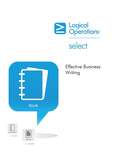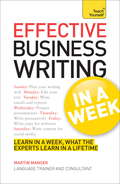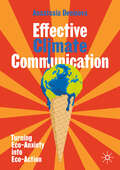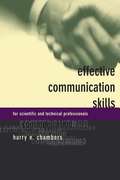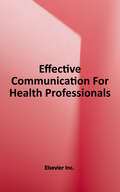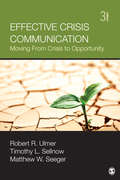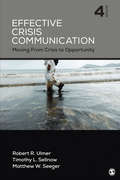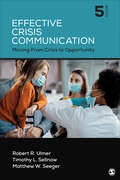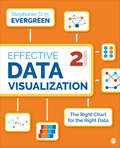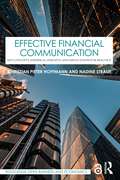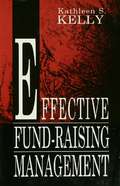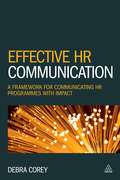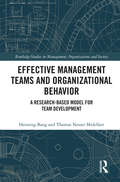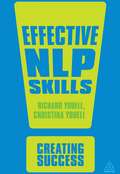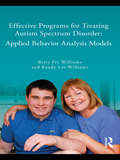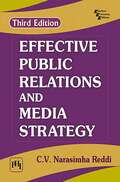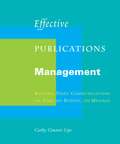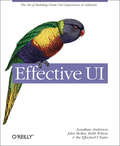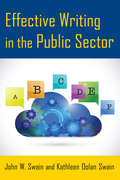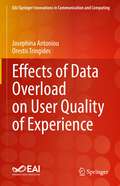- Table View
- List View
Effective Business Writing
by Edward SchelbThe topics covered in this books are: writing email and other electronic communication, writing effective business communication, writing a business letter and writing business proposals.
Effective Business Writing in a Week: Teach Yourself
by Martin ManserMost of us spend hours every day typing emails and other documents at work, yet howmany of us have ever had any training in writing skills? New and aspiring managersfind themselves having to write advertising copy or press releases, while manybusinesses want to engage successfully online. Effective Business Writing in a week isa practical guide to better communication at work, whether through more traditionalforms such as business reports or through email, websites and social media.Keywords:StyleStructureEmailBusiness reportsPresentationsLettersAdvertisingPress releasesLetterssocial mediawebsite copy
Effective Business Writing in a Week: Teach Yourself
by Martin ManserMost of us spend hours every day typing emails and other documents at work, yet howmany of us have ever had any training in writing skills? New and aspiring managersfind themselves having to write advertising copy or press releases, while manybusinesses want to engage successfully online. Effective Business Writing in a week isa practical guide to better communication at work, whether through more traditionalforms such as business reports or through email, websites and social media.Keywords:StyleStructureEmailBusiness reportsPresentationsLettersAdvertisingPress releasesLetterssocial mediawebsite copy
Effective Climate Communication: Turning Eco-Anxiety into Eco-Action
by Anastasia DenisovaThis book explores the urgent challenges of communicating climate change in the media. While many books have been written about climate change, this book goes to the very heart of what makes humans care about stories enough to act. In a direct and sympathetic approach, Denisova tackles problems of greenwashing, news narratives, colonial framings and more. Taking climate anxiety as a starting point, the author positions herself with empathy and asks the question: ‘what slows down citizen action?’ This fresh perspective acknowledges the pressing challenge of public disengagement and the anxiety people feel when faced with increasingly bleak headlines as the climate crisis intensifies. There is a surprising challenge to apocalyptic storytelling and a hero’s narrative, which Denisova argues are counter-productive, while solutions are provided for media storytellers. This book is essential reading for anyone seeking to ease climate-related anxiety and foster a deeper sense of empowerment in their audience.
Effective Communication Skills: For Scientific And Technical Professionals
by Harry E. ChambersFlatter, more collaborative organizational structures, combined with the pressure to translate innovative ideas into action quickly, are increasing the need by technical professionals-such as computer programmers, design specialists, engineers, and R&D scientists-to expand their repertoire of communication and managerial skills. In this highly accessible and practical book, Harry Chambers offers a wealth of strategies and tactics for building these skills, to the benefit of individuals, teams, and companies. In his trademark shoot-from-the-hip style, Chambers identifies specific real-world challenges that technical professionals face in the workplace, and offers definitive guidelines for enhancing their communication skills-from making presentations to giving and receiving criticism to navigating office politics. Featuring interviews with people in the trenches, as well as self-assessment tools and exercises, Effective Communication Skills will become a valued resource for technical professionals and their colleagues, trainers, and HR departments in all industries.
Effective Communication at Work: Speaking and Writing Well in the Modern Workplace
by Vicki McLeodDevelop effective communication skills for the office—in-person and onlineIn the digital age, as workers increasingly go remote, the ability to communicate clearly and effectively is—now more than ever—a highly desirable skill. Whether you talk, text, or email, Effective Communication at Work has everything you need to help boost your workplace performance and productivity.From honing listening to polishing speaking and writing skills, this essential guide delivers simple, powerful strategies and timely tips that can help you increase the impact of your business communication and correspondence both online and offline. Learn how to build stronger relationships and advance your career by mastering the art of effective communication.Effective Communication at Work includes:Expert advice—Get the latest tips for working and communicating in the digital world.Clarity is king—Discover a variety of effective communication styles and formats, including writing and speaking, with simplicity and accuracy.Cultivating relationships—Learn best practices for becoming a better human while working with others in an office environment, including mindfulness, empathy, diversity, and self-awareness.Gain a competitive edge by harnessing the power of effective communication.
Effective Communication for Health Professionals
by Elsevier IncEnsure you have the skills to effectively communicate with patients and other healthcare professionals! With its easy-to-read style, Effective Communication for Health Professionals, 2nd edition, is loaded with useful tips and exercises to help you learn the universal (and necessary) practice of communication. This full-color second edition reflects current therapeutic techniques, including Communication Guidelines feature boxes, Words at Work dialogue boxes, added case studies, and all-new content exploring the most current communication tools in the modern health care setting. In addition, interactive exercises on the Evolve companion website encourages you to practice therapeutic communication techniques in real-life situations. - UNIQUE! Interactive activities on accompanying Evolve site include a variety of application exercises such as scenarios with voice mail messages and patient/caregiver interviews. - Easy-to-read style provides practical information, hints, and tips. - Test Your Communication IQ boxes provide you with a short self-assessment test at the beginning of each chapter. - Spotlight on Success boxes provide you with useful, practical tips for improving workplace habits and communication. - Expanding Critical Thinking boxes provide actual case examples and activities with useful tips to help you apply what you've learned to practice. - Legal Eagle boxes provide useful tips that focus on honesty, as well as ethical and legal communication between patients and healthcare workers. - End-of-chapter questions and exercises help you to use knowledge learned from topics presented in the chapter. - NEW! Chapter devoted to cross-cultural communication promotes understanding of care in a diverse workplace - NEW! Chapter on diseases and disorders discusses communication with patients experiencing specific physical and mental illnesses and disorders. - NEW and UNIQUE! Words at Work dialogue boxes demonstrate actual conversations between healthcare workers and clients. - UPDATED! Content reflects the most current communication tools for the modern healthcare setting. - NEW! Full-color design and art program promote engagement. - NEW and UNIQUE! Communication Guidelines boxes direct you to best practices for the effective exchange of information. - NEW! Additional Taking the Chapter to Work case studies demonstrate real-life communication pitfalls and successes.
Effective Crisis Communication: Moving From Crisis to Opportunity
by Matthew W. Seeger Dr Robert R. Ulmer Dr Timothy L. SellnowIn this fully updated Third Edition, three of today’s most respected crisis/risk communication scholars provide the latest theory, practice, and innovative approaches for handling crisis. This acclaimed book presents a clear understanding about how to manage risks and crises effectively. The authors provide 18 in-depth case studies that highlight successes and failures in dealing with core issues of crisis leadership, managing uncertainty, communicating effectively, understanding risk, promoting communication ethics, enabling organizational learning, and producing renewing responses to crisis. Unlike other crisis communication texts, this book answers the question, “What now?” and explains how organizations can and should emerge from crisis. Authors Robert R. Ulmer, Timothy L. Sellnow, and Matthew W. Seeger provide guidelines for taking the many challenges that crises present and turning those challenges into opportunities.
Effective Crisis Communication: Moving From Crisis to Opportunity
by Matthew W. Seeger Dr Robert R. Ulmer Dr Timothy L. SellnowIn this fully updated Fourth Edition of Effective Crisis Communication, three of today’s most respected crisis/risk communication scholars provide the latest theories and innovative approaches for handling crisis. Unlike other crisis communication texts, this acclaimed book answers the question, “what now?” and explains how organizations can create the potential for opportunity, renewal, and growth through effective crisis communication. Authors Robert R. Ulmer, Timothy L. Sellnow, and Matthew W. Seeger provide guidelines for taking the many challenges that crises present and turning those challenges into opportunities. Practical lessons and in-depth case studies highlight successes and failures in dealing with core issues of crisis leadership, including managing uncertainty, communicating effectively, understanding risk, promoting communication ethics, enabling organizational learning, and producing renewing responses to crisis. New to the Fourth Edition: New and updated examples and case studies include diverse cases from recent headlines such as SeaWorld’s reaction to Blackfish, the United Airlines debacle, and the Flint Water Crisis. Updated theories and references throughout provide you with the latest information for effective crisis communication.
Effective Crisis Communication: Moving From Crisis to Opportunity
by Matthew W. Seeger Dr Robert R. Ulmer Dr Timothy L. SellnowIn this fully updated Fourth Edition of Effective Crisis Communication, three of today’s most respected crisis/risk communication scholars provide the latest theories and innovative approaches for handling crisis. Unlike other crisis communication texts, this acclaimed book answers the question, “what now?” and explains how organizations can create the potential for opportunity, renewal, and growth through effective crisis communication. Authors Robert R. Ulmer, Timothy L. Sellnow, and Matthew W. Seeger provide guidelines for taking the many challenges that crises present and turning those challenges into opportunities. Practical lessons and in-depth case studies highlight successes and failures in dealing with core issues of crisis leadership, including managing uncertainty, communicating effectively, understanding risk, promoting communication ethics, enabling organizational learning, and producing renewing responses to crisis. New to the Fourth Edition: New and updated examples and case studies include diverse cases from recent headlines such as SeaWorld’s reaction to Blackfish, the United Airlines debacle, and the Flint Water Crisis. Updated theories and references throughout provide you with the latest information for effective crisis communication.
Effective Crisis Communication: Moving From Crisis to Opportunity
by Robert R. Ulmer Matthew W. Seeger Timothy L. SellnowIn this fully updated Fifth Edition, three of today’s most respected crisis/risk communication scholars provide the latest theory, practice, and innovative approaches for handling crisis. This acclaimed book presents the discourse of renewal as a theory to manage crises effectively. The book provides in-depth case studies that highlight successes and failures in dealing with core issues of crisis leadership, managing uncertainty, communicating effectively, understanding risk, promoting communication ethics, enabling organizational learning, and producing renewing responses to crisis. Unlike other crisis communication texts, this book answers the question, "What now?" and explains how organizations can and should emerge from crisis. Authors Robert R. Ulmer, Timothy L. Sellnow, and Matthew W. Seeger provide guidelines for taking the many challenges that crises present and turning those challenges into opportunities for overcoming a crisis.
Effective Crisis Communication: Moving From Crisis to Opportunity
by Robert R. Ulmer Matthew W. Seeger Timothy L. SellnowIn this fully updated Fifth Edition, three of today’s most respected crisis/risk communication scholars provide the latest theory, practice, and innovative approaches for handling crisis. This acclaimed book presents the discourse of renewal as a theory to manage crises effectively. The book provides in-depth case studies that highlight successes and failures in dealing with core issues of crisis leadership, managing uncertainty, communicating effectively, understanding risk, promoting communication ethics, enabling organizational learning, and producing renewing responses to crisis. Unlike other crisis communication texts, this book answers the question, "What now?" and explains how organizations can and should emerge from crisis. Authors Robert R. Ulmer, Timothy L. Sellnow, and Matthew W. Seeger provide guidelines for taking the many challenges that crises present and turning those challenges into opportunities for overcoming a crisis.
Effective Data Visualization: The Right Chart for the Right Data
by Stephanie EvergreenNOW IN FULL COLOR! Written by sought-after speaker, designer, and researcher Stephanie D. H. Evergreen, Effective Data Visualization shows readers how to create Excel charts and graphs that best communicate their data findings. This comprehensive how-to guide functions as a set of blueprints—supported by both research and the author’s extensive experience with clients in industries all over the world—for conveying data in an impactful way. Delivered in Evergreen’s humorous and approachable style, the book covers the spectrum of graph types available beyond the default options, how to determine which one most appropriately fits specific data stories, and easy steps for building the chosen graph in Excel. Now in full color with new examples throughout, the Second Edition includes a revamped chapter on qualitative data, nine new quantitative graph types, new shortcuts in Excel, and an entirely new chapter on Sharing Your Data With the World, which provides advice on using dashboards. New from Stephanie Evergreen! The Data Visualization Sketchbook provides advice on getting started with sketching and offers tips, guidance, and completed sample sketches for a number of reporting formats. Bundle Effective Data Visualization, 2e, and The Data Visualization Sketchbook, using ISBN 978-1-5443-7178-8!
Effective Data Visualization: The Right Chart for the Right Data
by Stephanie EvergreenNOW IN FULL COLOR! Written by sought-after speaker, designer, and researcher Stephanie D. H. Evergreen, Effective Data Visualization shows readers how to create Excel charts and graphs that best communicate their data findings. This comprehensive how-to guide functions as a set of blueprints—supported by both research and the author’s extensive experience with clients in industries all over the world—for conveying data in an impactful way. Delivered in Evergreen’s humorous and approachable style, the book covers the spectrum of graph types available beyond the default options, how to determine which one most appropriately fits specific data stories, and easy steps for building the chosen graph in Excel. Now in full color with new examples throughout, the Second Edition includes a revamped chapter on qualitative data, nine new quantitative graph types, new shortcuts in Excel, and an entirely new chapter on Sharing Your Data With the World, which provides advice on using dashboards. New from Stephanie Evergreen! The Data Visualization Sketchbook provides advice on getting started with sketching and offers tips, guidance, and completed sample sketches for a number of reporting formats. Bundle Effective Data Visualization, 2e, and The Data Visualization Sketchbook, using ISBN 978-1-5443-7178-8!
Effective Financial Communication: Key Concepts, Empirical Insights, and Implications for Practice (Routledge Open Business and Economics)
by Christian Pieter Hoffmann Nadine StraußFinancial communication and investor relations are strategic corporate functions, tasked with fostering relationships with financial audiences, such as investors, analysts, and journalists. These financial audiences are of critical importance to the establishment, growth, and sustainable success of corporations. This book draws on insights from finance and accounting research, economics, and psychology as well as media and communication studies to explain the role of effective financial communication in corporate disclosure, storytelling, and relationship management on capital markets.It explores both theories of and empirical evidence for effects of financial communication on key audiences and derives principles for effective financial communication and investor relations. This book develops a distinct perspective, guiding readers through the state of research by focusing on the effects and effectiveness of financial communication. For both practice and academia, it derives evidence-based implications for the role and management of financial communication and investor relations.This book makes a valuable resource for scholars and graduate students studying or researching investor relations and financial communication across schools of communication, finance and accounting, and business and management. Offering practical implications, it will also serve as a much-needed guide for practitioners.
Effective Fund-Raising Management (Routledge Communication Series)
by Kathleen S. KellyIn a ground-breaking departure from existing works, almost all of which are how-to manuals based on anecdotal evidence, this is the first academic textbook on fund raising. By integrating practical knowledge with social science theory and research, it presents a comprehensive approach to the function, from its legal and ethical principles to the managerial process by which gifts are raised. Territory previously uncharted in the literature is explored, such as the historical and organizational contexts of contemporary practice. Explanations of programs, techniques, and publics introduce a new system for understanding fund raising's major concepts. Unlike efforts in established fields, most of the material represents original scholarship undertaken to produce a first-time text. The book's main purpose is to teach students about fund raising--a high-demand, high-paying occupation that will continue to expand into the 21st century as the need for trained practitioners exceeds the supply. During the last decade, fund-raising education moved into the formal classroom and away from an apprenticeship tradition of senior practitioners mentoring newcomers. Yet until now, there has not been a textbook to support this evolving professionalism. Faculty have been reluctant to define fund raising as an academic subject in the absence of a theory-based teaching resource, and courses usually have been assigned to part-time instructors hired from the practice. This textbook addresses the void. It is designed for graduate and upper-level undergraduate courses dealing with fund raising as a primary or secondary subject. Among its features, each chapter points out research gaps and opportunities--such as problems and theories for master's theses and doctoral dissertations--and ends with a list of suggested readings. The text is appropriate for the diverse academic areas in which fund raising, nonprofit management, and philanthropy are taught, including public administration, management, arts and humanities, education, social work, economics, and sociology. Because of its public relations orientation, it is particularly suited for courses offered in that discipline. Additional audiences are practitioners enrolled in professional development programs; CEOs, trustees, and others interested in self-study; and scholars who need serious literature on the subject.PROFESSIONAL PROMO PIECE COPY..............Recently, the field of fundraising seems to have taken a giant step backward. Rather than conducting principled efforts to support common political, educational, financial, or social causes, the entire process is making headlines as a venue offering opportunities for influence peddling, corruption and self-promotion. The need for a guide to ethical fund-raising management is greater than ever. Effective Fund-Raising Management addresses this need.The most successful fundraisers understand why certain practices are more effective than others. What works in one situation may not work in another similar--but slightly different--situation. That is why theoretical understanding is vital to fundraising professionals. To be an expert practitioner, one must have have enough theoretical understanding to adapt one's practice to a variety of situations. That is the purpose of Effective Fund-Raising Management--to provide the underlying theoretical and conceptual understandings that enable an effective practitioner to become an expert practitioner.Indispensable to fund-raising professionals, this invaluable resource: * reviews the entire scope of the fund-raising profession-- from its historical antecedents to the current legal, ethical, organizational, and theoretical principles underlying its practice today;* provides concise definitions and explanations of the fund-raising process and its position within the field of public relations;* links effective fund-raising practices to ethical considerations; and * examines four of the major methods of fund raising-- annual giving, major gifts, planned giving, and capital campaigns.
Effective HR Communication
by Debra CoreyIn today's competitive environment where we are doing everything we can to compete for talent, effective communication ensures we are showcasing our HR programmes in a way which will help us attract, retain and engage talent. Whether introducing new HR programmes or re-launching existing ones, communications help us deliver the key messages so that employees understand, appreciate and action them to meet our HR and business objectives. Effective HR Communication is a practical guide to develop and deliver effective communication campaigns, ensuring that teams have the knowledge, skills and tools to achieve the desired objectives. Effective HR Communication introduces a six-step 'IMPACT' model to explain and demonstrate the critical steps to be followed when developing a communications campaign. This includes steps such as understanding the communication needs and requirements of employees, developing the most robust objectives, selecting and developing the appropriate medium, planning a campaign in an effective manner, leveraging the support of business partners, developing effective communications content, and measuring the success of the campaign. Using a combination of theory, examples, tips and tools from leading experts, this book provides practical information which can easily be used to create effective and impactful communications. Case studies from leading organisations such as BT, LV=, Merlin Entertainments and Reward Gateway are included to further illustrate how communication has been done effectively.
Effective Management Teams and Organizational Behavior: A Research-Based Model for Team Development (Routledge Studies in Management, Organizations and Society)
by Henning Bang Thomas Nesset MidelfartMost contemporary organizations use management teams to manage and coordinate their businesses at all levels of the organizational hierarchy. Management teams typically set overall goals, strategies, and priorities, making vital organizational decisions. They discuss issues, solve problems, offer advice, and ensure various processes and units are aligned and interact efficiently. Although management teams are vital for overall organizational performance, research indicates that they are largely underused and less effective than their potential would suggest for value creation. This book provides a research-based and practical model of the characteristics of effective management teams. It looks in depth at each factor of the model, discusses the supporting research, provides examples of how the factors influence the work and effectiveness of management teams, and shares tips and tools for successfully working with management team development. It provides researchers, academics, and students of organizational behavior with an overview of the variables that empirical research has found to be robustly related to management team effectiveness and will enable leaders and management consultants to develop more effective management teams.
Effective NLP Skills
by Richard Youell Christina YouellNeuro Linguistic Programming (NLP) is one of the most powerful communication tools available. It helps you understand what makes people tick, helps you to influence and persuade people and gives you an insight into what really happens when we communicate. Effective NLP Skills, 2nd edition, covers all the NLP models, tools, skills and behaviours you need, and teaches you how to channel this knowledge into improving your performance at work. You will discover how to manage yourself and others, how to use language to get what you want, outcome thinking, how to build rapport and how to motivate others. With crucial insight into the workings of the brain and essential techniques to enhance your learning, Effective NLP Skills is for anyone who wants to utilise the NLP model to get ahead in their career.
Effective Programs for Treating Autism Spectrum Disorder: Applied Behavior Analysis Models
by Betty Fry Williams Randy Lee WilliamsEffective Programs for Treating Autism Spectrum Disorder is written for teachers, parents, and the many service providers who work with individuals with autism spectrum disorder (ASD). Part one reviews the characteristics of ASD, summarizes major theories and research findings regarding cause(s) of ASD, and discusses the most popular treatment claims, examining each approach's scientific base and value. Part two provides an informative overview of applied behavior analysis, focusing on the principles of learning and basic procedures based upon those principles. These two parts provide a foundation for understanding the strategies implemented by the outstanding treatment programs described in Part three. The eight models described in Part three represent comprehensive, evidence-based programs for the treatment of persons with ASD, from infancy through adulthood. Programs reviewed include the Lovaas Institute, Koegel Center, Strategic Teaching and Reinforcement Systems (STARS), Project DATA, New England Children's Center, May Institute, Princeton Child Development Institute, and Judge Rotenberg Center. Strategies explained include intensive early behavioral intervention, Pivotal Response Training, verbal behavior, script fading, social stories, visual activity schedules, functional analysis, the Picture Exchange Communication System, and the Family-Teaching Model.
Effective Public Relations And Media Strategy
by C. V. NarasimhaThe author with over five decades of professional and academic experience has considerably revised and updated every chapter of the book to present, contemporary diverse public relations and media practices. As a result, the new edition contains the best of previous editions and at the same time replaces all the dated material with new figures and advanced information. Subjects like Mass Communication, Public Relations, Journalism, Advertising, Media Studies, Event Management, PR 2.0 New Model and eight case studies including Mahatma Gandhi World's Greatest Communicator - all in one make this edition truly unique and the only textbook of this type in India. The other key topics that have been given attention in the book include PR as a Strategic Management Function; Communication Models: History of Indian PR; Standards and Ethics in PR; Corporate Communications; PR in Government, Public Sector and NGOs; Global PR; Internet and Social Media; Multimedia PR Campaign and PR into the Future. Learning Tools Students learning tools such as Chapter Opening Preview, Relevant Case Problems in the Text, End of the Chapter Summary for quick understanding, Review Questions for practice, the Glossary and traits needed for success in PR career are added value to this edition. The text is a must read for every student, faculty and practitioners of Mass Communication, Media Relations, Journalism, PR & Advertising and all management disciplines.
Effective Publications Management: Keeping Print Communications on Time, on Budget, on Message
by Cathy Connor LipsMaster the details of creating, contracting, and overseeing print materials, and make your communication projects-annual reports, brochures, newsletters, and other publications-run smoothly.Each chapter is dedicated to a different phase of the process. Topics include determining your communication needs, educating clients, creating proposals, planning schedules and budgets, hiring a creative team, selecting printers, and much more. Award-winning creative directors, art directors, designers, editors, and consultants share their publications-management strategies and exemplary work. Sample project schedules, budgets, and vendor contracts are provided.- One phase of the publication process per chapter - Ideal for professionals in corporate and nonprofit communications and marketing, for graphic designers, and for design and business students - Great reference for anyone creating or overseeing any type of print publication, novices as well as seasoned professionals who can benefit from industry experts knowledge - 58 color images plus 18 sample schedules, budgets, contracts, and more!
Effective UI: The Art of Building Great User Experience in Software
by Jonathan Anderson John Mcree Robb Wilson The EffectiveUI TeamPeople expect effortless, engaging interaction with desktop and web applications, but producing software that generates enjoyable user experiences is much harder than many companies anticipate. With Effective UI, you'll learn proven user-experience strategies that will satisfy your clients and customers, drive business value, and increase brand strength. This book shows you how to capture the collaborative and cooperative spirit among designers, engineers, and management required for building engaging software. You'll also learn valuable methods for maintaining focus throughout the process -- whether you're a product manager who needs a clear roadmap, a developer or designer looking for guidance and advocacy, or a businessperson who wants to understand and manage user-experience software initiatives. Learn how to build software that will:Generate engaging and interactive experiences between consumers and businesses, or between businesspeople and their information systems Account for how people work with, think about, and consume information Establish a richer means of collaboration and communication Reduce frustration by streamlining complex tasks and creating processes that are more intuitive Distinguish products, services, and brands to create a competitive advantage Create scalable systems that adapt to changing user needs and behaviors
Effective Writing in the Public Sector
by John W. Swain Kathleen Dolan SwainIntended for both students and practitioners in public administration who want to communicate more effectively with a variety of audiences, this book offers clear, easy-to-understand guidelines on how to write more clearly, concisely, and coherently, as well as correctly. It covers the basics of good English and applies those basics to general forms (such as memos, letters, and e-mails) and more specific forms (such as newsletters, proposals, budget justifications, and rules) used in the public sector.
Effects of Data Overload on User Quality of Experience (EAI/Springer Innovations in Communication and Computing)
by Josephina Antoniou Orestis TringidesThis book introduces a unique perspective on the use of data from popular emerging technologies and the effect on user quality of experience (QoE). The term data is first refined into specific types of data such as financial data, personal data, public data, context data, generated data, and the popular big data. The book focuses the responsible use of data, with consideration to ethics and wellbeing, in each setting. The specific nuances of different technologies bring forth interesting case studies, which the book breaks down into mathematical models so they can be analyzed and used as powerful tools. Overall, this perspective on the use of data from popular emerging technologies and the resulting QoE analysis will greatly benefit researchers, educators and students in fields related to ICT studies, especially where there is additional interest in ethics and wellbeing, user experience, data management, and their link to emerging technologies.
